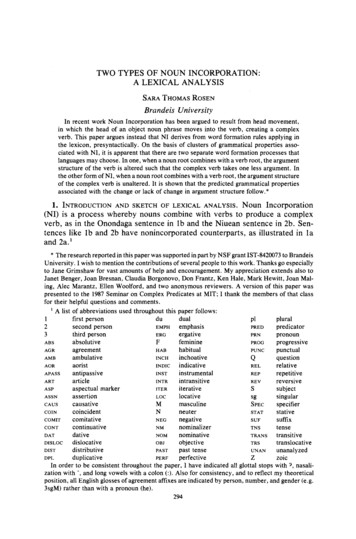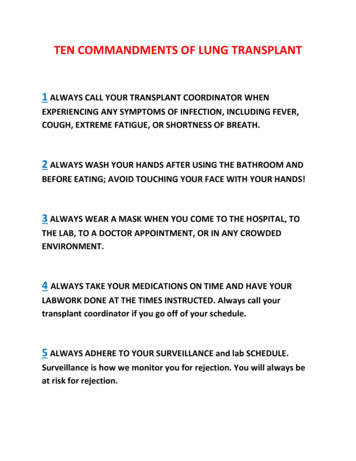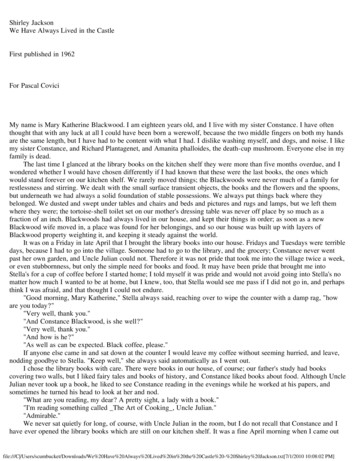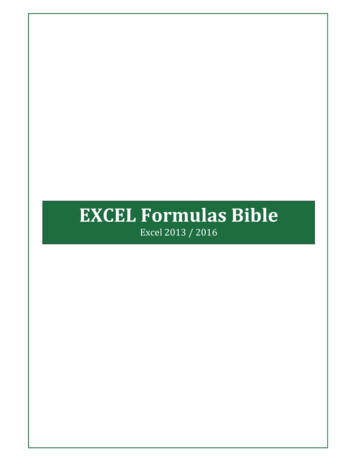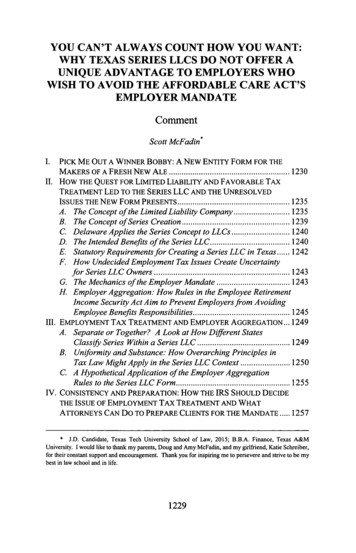
Transcription
YOU CAN'T ALWAYS COUNT HOW YOU WANT:WHY TEXAS SERIES LLCS DO NOT OFFER AUNIQUE ADVANTAGE TO EMPLOYERS WHOWISH TO AVOID THE AFFORDABLE CARE ACT'SEMPLOYER MANDATECommentScott McFadin*I.PICK ME OUT A WINNER BOBBY: A NEW ENTITY FORM FOR THE. 1230.MAKERS OF A FRESH NEW ALEII. How THE QUEST FOR LIMITED LIABILITY AND FAVORABLE TAXTREATMENT LED TO THE SERIES LLC AND THE UNRESOLVEDISSUES THE NEW FORM PRESENTS. 1235A.B.C.D.E.F.The Concept of the Limited Liability Company . 12351239The Concept ofSeries Creation .DelawareApplies the Series Concept to LLCs. 1240The Intended Benefits of the Series LLC. 1240Statutory Requirementsfor Creatinga Series LLC in Texas. 1242How Undecided Employment Tax Issues Create Uncertaintyfor Series LLC Owners . 1243. 1243G. The Mechanics of the Employer MandateH. Employer Aggregation: How Rules in the Employee RetirementIncome Security Act Aim to Prevent Employers from Avoiding. . 1245Employee Benefits Responsibilities.m. EMPLOYMENT TAX TREATMENT AND EMPLOYER AGGREGATION. 1249A. Separateor Together? A Look at How Diferent StatesClassify Series Within a Series LLC . 1249B. Uniformity and Substance: How OverarchingPrinciples inTax Law Might Apply in the Series LLC Context . 1250C. A HypotheticalApplication of the Employer AggregationRules to the Series LLC Form. 1255IV. CONSISTENCY AND PREPARATION: How THE IRS SHOULD DECIDETHE ISSUE OF EMPLOYMENT TAX TREATMENT AND WHATATTORNEYS CAN DO TO PREPARE CLIENTS FOR THE MANDATE . 1257* J.D. Candidate, Texas Tech University School of Law, 2015; B.B.A. Finance, Texas A&MUniversity. I would like to thank my parents, Doug and Amy McFadin, and my girlfriend, Katie Schreiber,for their constant support and encouragement. Thank you for inspiring me to persevere and strive to be mybest in law school and in life.1229
1230TEXAS TECHLAWREVIEW[Vol. 46:1229A. The IRS Should Treat Each Series of a Series LLC as a SeparateEmployerfor Employment Tax Purposes . 1257B. PractitionersNeed to be Mindful of the PotentialEffect ofEmployerAggregation Rules When Consideringthe SeriesLLC Form. 1258V. SERIES LLCs ARE MOST LIKELY NOT A VIABLE WAY TO AVOIDTHE EMPLOYER MANDATE. 1260I. PICK ME OUT A WINNER BOBBY: A NEW ENTITY FORM FOR THEMAKERS OF A FRESH NEW ALESeries limited liability companies (series LLCs) are a new business entitymeant to offer administrative ease and cost savings to business owners seekingto limit risk and liability.' At first glance, series LLCs seem to offer everythingbusiness owners want from an entity form.2 Notwithstanding the potentialbenefits of this new entity form, series LLCs also present many unresolvedissues that could sneak up on unwary business owners if their attorneys areunprepared.3 One such issue is the employer mandate in the Patient Protectionand Affordable Care Act (Affordable Care Act), which requires employers offifty full-time equivalent employees to provide healthcare or pay an annualpenalty.4 Series LLCs can be hard to understand without appropriate context. 5For a practical example of how the employer mandate could affect series LLCs,consider the following hypothetical.In the autumn of 2012, Johnny Manziel burst onto the college footballscene.6 His daring exploits and endless capacity for big plays led the Aggies toan 11 and 2 record in the team's first season of Southeastern Conference play,igniting an Aggie euphoria, the likes of which had not been seen since the glorydays of Jackie Sherrill. Looking to capitalize on the rabid Aggie fan base'sinsatiable desire for Aggie football-related items, craft brew wannabe and1. See Michelle Harner, Jennifer Ivey-Crickenberger & Tae Kim, Series LLCs: What Happens WhenOne Series Fails? Key Considerations and Issues, Bus. L. TODAY, Feb. 2013, at 1, 1.2. See Amanda J. Bahena, Note, Series LLCs: The Asset ProtectionDream Machines?, 35 J. CORP. L.799, 805-06 (2010) ("The [series LLC], with its internal divisions and low filing costs, might become the nextasset-protection dream machine.").3. See discussion infra Part H.F.4. See Mary Ann Chirba-Martin, ERISA Preemption ofState "Playor Pay" Mandates: How PPACAClouds an Already Confising Picture, 13 J. HEALTH CARE L. & POL'Y 393, 397-98 (2010).5. See discussion infra Part II.A-B.6. See Michael Weinreb, All HailJohnny Football:The Legendofl9-Year-OldJohnnyManziel Growsin Tuscaloosa, GRANTLAND (Nov. 12, 2012), a-legendjohnny-football-manziel-grows/. Johnny Manziel is commonly referred to by his nickname-"JohnnyFootball." Id7. Jackie Sherrill, SR/COLLEGE FOOTBALL, sherrill-1.html (last visited Apr. 15, 2014). Jackie Sherrill coached the Aggies from 1982 to 1988 andcemented his status as an Aggie legend by leading the team to three consecutive Southwest ConferenceChampionships and Cotton Bowl victories. Id. To put icing on the cake, Sherrill also coached the Aggies tofive straight victories over their rival Longhorns from 1984 to 1988. Id.
2014]YOU CAN'T ALWAYS COUNT HOW YOU WANT1231Aggie graduate Bobby Brewer sought to create an ale that would remind allAggies of the hope that springs eternal at the beginning of every footballseason. After scouring the planet for the finest possible ingredients and homebrewing the recipe to perfection, Bobby believed he had finally concocted abeer that would become the game-day brew of choice for Aggie football fanseverywhere. His masterpiece of home brewing genius? A velvety, marooncolored ale with a crisp, refreshing finish that he would call "Maroon KoolAid." 8Looking to spread the gospel of his fresh new ale across the Aggieuniverse, Bobby took a batch of the brew to the headquarters of TexAgs.com(TexAgs) and convinced the staff to sample some Maroon Kool Aid.9 Much toBobby's delight, TexAgs' staff and owners loved the beer's unique color andtaste. TexAgs immediately offered Bobby advertising space and even agreed toincorporate Maroon Kool Aid into an upcoming special offer on TexAgspremium subscriptions. 0 Under the special offer, TexAgs offered a lowmonthly rate of 2 and a free six-pack of Maroon Kool Aid to every newTexAgs user who subscribed on any day between December 1, 2012, andJanuary 4, 2013-the date of the 2013 Cotton Bowl. Even though Bobbywould be forced to take a loss by providing free beer, he decided that it wouldmore than pay off as a way to build some name recognition, brand loyalty, andword-of-mouth advertising for his beer. The strategy paid off; TexAgs usersresponded in force to the special offer and Bobby ultimately ended up bottlingand shipping 1,000 six-packs from his kitchen. As an added marketing ploy,Bobby included an eye-catching card with each six-pack directing customers tohis website, www.maroonkoolaid.com, if they wished to order more beer.Thanks to the special offer, Bobby's clever advertising, and positive wordof-mouth among Aggie fans, Bobby's business exploded in the first half of2013. To keep up, Bobby hired some of his best friends from college who wereburned out on their investment banking jobs, flush with cash, and looking to trysomething new-Ben Borns and Ryan Rhino. The three budding entrepreneursmoved to College Station, Texas, to build their brewery from the ground up.Bobby, Ben, and Ryan (hereinafter referred to by their first names or as "themembers") planned to build a vertically integrated brewing and distributioncompany." Before the three bought any land, shipped any more beer, or made8. "Maroon Kool Aid" is a reference to an Aggie football fan's uncanny ability to convince himself thatthe football team is going to reach unprecedented levels of success. Those holding such undying beliefs aresaid to be "drinking the Maroon Kool Aid."9. See TEXAGS, http://texags.com/ (last visited Apr. 15, 2014). TexAgs.com is an extremely popularAggie website on which fans of Aggie football discuss the team. See id.10. See TEXAGS PREMIUM wrrH BILLY LIucci, http://texags.com/premium (last visited Apr. 15, 2014).TexAgs Premium is a service through which TexAgs users pay a monthly fee to receive access to insideinformation and recruiting scoop on Aggie football provided by recruiting guru Billy Liucci. See generallyBilly Liucci: TexAgs Senior Writer, TEXAGs, http://texags.com/premiumffagFeed/1 79 (last visited Apr. 15,2014) (detailing a brief biography of Mr. Liucci).11. See generally Idea: Vertical Integration, EcoNOMIST (Mar. 30, 2009), http://www.economist.com/nodell3396061 (defining vertical integration as "the merging together of two businesses that are at
1232TEXAS TECH LAW REVIEW[Vol. 46:1229contracts for supplies, they wanted to pick a legal structure for their business.Unsure what entity to select, Bobby contacted his friend in law school, SammyStockman, and asked him what entity would be best for the budding brewkings. Stockman immediately touted the wonders of a new business entity hehad learned about in class: the series LLC.Stockman explained that the series LLC form would provide limitedliability for each member, cost savings, and an opportunity to structure theirbusiness in such a way that each segment of the business would be immunefrom litigation against a different segment.12 Thrilled with Stockman's advice,Bobby, Ben, and Ryan went to the office of a College Station attorney, KeithMoore, and requested that he do the necessary paperwork to form a series LLC.Although Mr. Moore reminded them that series LLCs were relatively newentities and presented many unresolved issues that could sneak up on them inthe future, the boys still wanted to use the series LLC form. They wereconvinced that series LLCs were the entities of the future.Keith acquiesced to their wishes and completed the necessary steps tocreate a Texas series LLC for Bobby, Ben, and Ryan. First, Keith drafted acertificate of formation for the series LLC. Keith noted that Maroon BrewsLLC would be the "master LLC."l3 In the certificate of formation, Keith alsonoted that Maroon Brews LLC would encompass two series. Series A (theBottling series) would own the brewing and bottling equipment and its mainbusiness function would be to take raw ingredients and turn them into sweet,delicious beer. Series B (the Distribution series) would hire full-time driversand deliver the beer to liquor stores and bars. In separating the businessfunctions this way, Keith hoped to protect the assets of the Bottling series fromthe lawsuits that could result if any delivery drivers got into serious accidents.To comply with the statutory requirements for creating a liability shield aroundeach series, Keith also noted the separate nature and shielded liability of eachseries in the certificate of formation.14 Furthermore, Keith drafted an operatingagreement for each series within Maroon Brews. Bobby would have a 50%interest and would receive 50% of the profits from each series, while Ben andRyan would each have a 25% interest and would receive 25% of the profitsfrom each series.After Keith filed Maroon Brews's certificate of formation with theSecretary of State for the State of Texas, he informed Bobby, Ben, and Ryanthat they needed to keep separate books and records for the Bottling series andthe Distribution series in order for their separate nature to be recognizeddifferent stages of production").12. Harner, Ivey-Crickenberger & Kim, supra note 1, at 1. A series LLC is a new entity that aims toprovide the benefits of a structure involving multiple traditional LLCs while providing cost savings. Seeid. Using this form, the owners of a business can create one "master LLC" and separate LLCs, called series,to serve different business functions beneath the master LLC. Id.13. See id.14. See TEX. BUS. ORGS. CODE ANN. § 101.602(b)(2H3) (West 2012).
2014]YOU CAN'T ALWAYS COUNT HOW YOU WANT1233according to the statute.' 5 Confident that he had done all he could to makeMaroon Brews a success, Keith sent the boys off into the wild world of craftbrewing.Maroon Brews navigated the craft brew wilderness well. During thecourse of the 2013 football season, Maroon Kool Aid became the tailgate andgame day beer of choice for Aggies everywhere. In fact, by the end of 2013,the Bottling series had twenty-five full-time employees between front office andbrewery staff, and the Distribution series had twenty-five full-time drivers. Thebusiness continued to grow in 2014 as Maroon Kool Aid gained popularitythroughout Texas. Even though Maroon Brews was gaining more customersand selling more beer, it still did not have a lot of cash on hand due to theamount of expenses and debt it incurred to finance the acquisition of a brewingfacility, brewing equipment, and trucks for distribution.At the beginning of 2015, Maroon Brews became aware of a problem ithad not anticipated when it originally chose the series LLC form. When theemployer mandate in the Affordable Care Act goes into effect in 2016, willMaroon Brews have to provide healthcare insurance to its full-time employeesor pay a penalty if it chooses not to do so?16 The Bottling series has twentyfive employees and the Distribution series has twenty-five employees. Eventhough none of the series individually has fifty employees, the whole operationhas a total of fifty full-time employees. Will the Internal Revenue Service(IRS) treat each series as a separate entity when applying the mandate, or willevery employee simply be counted as the responsibility of Maroon Brews as awhole? Unsure what to do, the brew masters returned to Keith's office to seek15. See id. § 101.602(b)(1).16. See supranote 4 and accompanying text. President Barack Obama signed the Affordable Care Actinto law on March 23, 2010. Health Care that Works for Americans, THE WHITE HOUSE, overview (last visited Apr. 15, 2014). The Affordable Care Actsought to boost the availability of healthcare coverage and decrease healthcare costs. See Nat'l Fed'n ofIndep. Bus. v. Sebelius, 132 S. Ct. 2566, 2580 (2012). As part ofthat effort, Congress included an employermandate requiring employers with at least fifty full-time employees to provide health coverage or pay anannual penalty when certain conditions are met. See Chirba-Martin, supra note 4, at 397-98. Although theemployer mandate was supposed to be implemented in 2014, the Obama administration has delayed themandate twice. See Juliet Eilperin & Amy Goldstein, White House Delays Health InsuranceMandateforMedium-Sized Employers Until 2016, WASH. POST (Feb. 10, 2014), 6b344-9279-1 le3-84e1 -27626c5ef5fb story.html. First, the Obama administration announcedthat the mandate would not be enforced until 2015. See Sarah Kliff, White House Delays Employer MandateRequirement Until 2015, WASH. POST WONKBLOG (July 2, 2013, 5:51 PM), rement-until-2015/ (notingthat "[tihe Obama administration will not penalize businesses that do not provide health insurance in 2014").Recently, the administration announced that the mandate would not be enforced against employers with fiftyto ninety-nine full-time employees until 2016. See Shared Responsibility for Employers Regarding HealthCoverage, 79 Fed. Reg. 8544, 8574 (proposed Feb. 12, 2014) (to be codified at 26 C.F.R. pt. 301); Statementon Delay in Some Employers' Health-InsuranceMandate, WALL STREET J. (Feb. 10, 2014, 4:19 andatel.Because of these two delays, Maroon Brews would not be responsible for providing healthcare until 2016.See Shared Responsibility for Employers Regarding Health Coverage, 79 Fed. Reg. at 8574.
1234TEXAS TECH LAWREVIEW[Vol. 46:1229advice on how the employer mandate would be applied. What should Keith tellthem?The series LLC is a relatively new business form that presents manyunsettled issues.17 The form allows business owners to form one master LLCand as many individual series as they prefer within that master LLC.'8 The newentity form aims to provide convenience to business owners to allocate differentbusiness functions and risks among different series without having to pay extrafiling fees to form multiple traditional entities.' 9 Despite the intended benefits,series LLCs present many uncertainties that attorneys need to be mindful of.20Specifically, the IRS has not yet determined whether it will treat each serieswithin a series LLC as a separate legal entity for employment tax purposes.2'As a result, it is uncertain how the employer mandate will be applied in a seriesLLC context. 22 This Comment addresses the issues of how a series should betreated for employment tax purposes and discusses how the employer mandatewill likely be enforced against a Texas series LLC. Part I provides a briefdefinition of series LLCs and presents a hypothetical situation in which ownersof a Texas LLC are unsure whether or not they will be subjected to a penalty ifthey do not provide healthcare to their employees.2 3 Part 11 provides a historyof the development of the series LLC, a summary of the intended benefits of theseries LLC, and a discussion of the legal rules that will be relevant in analyzinghow the employer mandate will apply to the series LLC form.24 Part IIIanalyzes the legal principles the IRS will likely use in deciding the issue ofclassification of series LLCs for employment tax purposes.2 ' Furthermore, PartIII then applies the rules that the IRS will likely use in enforcing the employermandate to the facts of the hypothetical in this introduction. 26 Part IV providesrecommendations as to how the IRS should resolve the employment taxclassification issue and contains recommendations for practitioners to prepareseries LLC clients for the mandate. 27 Lastly, Part V comments on the viabilityof the series LLC as an entity choice in light of how the employer mandate willlikely be applied to the form.2 817. See discussion infra Part II.F.18. See discussion infraPart II.B. The term "master LLC" is borrowed from Harner, Ivey-Crickenberger& Kim, supra note 1, at 1.19. See discussion infra Part H.D.20. See discussion infra Part IIF.21. See infra notes 107-09 and accompanying text.22. See discussion infra Part II.F.23. See discussion supra notes 1-22 and accompanying text.24. See discussion infra Part [I.25. See discussion infra Part III.26. See discussion infra Part 111.27. See discussion infra Part IV.28. See discussion infra Part V.
2014]YOU CAN'TALWAYS COUNT HOW YOU WANT1235II. How THE QUEST FOR LIMITED LIABILITY AND FAVORABLE TAXTREATMENT LED TO THE SERIES LLC AND THE UNRESOLVED ISSUES THENEW FORM PRESENTSA. The Concept of the Limited Liability CompanyGeneral partnerships and partnership associations paved the way for thelimited liability company (LLC).29 Popularized in the latter half of the 19thcentury, a general partnership is a "business owned by more than one person." 30This structure benefited owners by (1) allowing them to contract with eachother and determine how profits and losses would be allocated; (2) providingflexibility in the management of the company; and (3) allowing owners todecide how the division of assets would take place when one partner left theventure. 3 1 Despite the benefits, general partnerships did not provide limitedliability to owners.32 Instead, courts applied agency law to partners in apartnership, which meant that a third party could recover against individualpartners even if he were not the partner who had breached a contract orcommitted a tort against the third party.33 Unlike a general partnership,however, partnership associations offered limited liability for all partners in the29. See Wayne M. Gazur& Neil M. Goff, Assessing the LimitedLiability Company, 41 CASE W. RES.L. REv. 387, 393 (1991).30. ERIC A. CHIAPPINELLI, CASES AND MATERIALS ON BUSINESS ENTITIES 727 (2d ed. 2010); seeDeborah A. DeMott, Beyond Metaphor:An Analysis ofFiduciaryObligation,1988 DUKE L.J. 879, 911 n.147(1988) ("In the United States, the Uniform Partnership Act defines partnership as 'an association of two ormore persons to carry on as co-owners a business for profit."' (quoting UNIFORM PARTNERSHIP ACT §6(1)(1969))).31. CHIAPPINELLI, supranote 30, at 727; see Richard A. Epstein, In Defense ofthe Contractat Will, 51U. CHI. L. REv. 947, 958-62 (1984). Courts also created presumptions in case partners did not includecertain basic components in their contractual agreement. CHIAPPINELLI, supra note 30, at 727. Thesepresumptions were "a presumption of symmetry, a presumption of equality, and a presumption that thecontracts [were] personal such that another person could not be substituted for, or added to, the originalowners." Id. The presumption of symmetry forced partners to use proportion to divide profits and losses inthe absence of a contractual agreement to do otherwise. Id. The presumption of equality gave each partnerequal management rights and provided that disagreements about strategy or other matters would be decided bya majority vote of the partners, regardless of their individual ownership share. Id.; see Paul Carman, InSearchofPartner'sInterest in the Partnership:The Alternative ofSubstantialEconomic Effect, 107 J. TAX'N214, 217 (2007) (noting a court's reliance on the presumption of equality "[iun determining the partner'sinterest in the partnership"). Lastly, the presumption of a personal contract did not allow a partner to transferhis interest in the business to another and required a unanimous vote before one could become a partner in theventure. CHIAPPINELLI, supranote 30, at 727; see Daniel J.H. Greenwood, The DividendPuzzle: Are SharesEntitled to the Residual?, 32 J. CORP. L. 103, 121-22 n.55 (2006) (noting the "requirement of unanimousconsent for any fundamental change in the business").32. See CHIAPPINELLI, supranote 30, at 727; Robert R. Keatinge et al., The LimitedLiability Company:A Study ofthe EmergingEntity, 47 BUS. LAw. 375, 380 (1991-1992) (noting that "all partners are jointly andseverally liable for all obligations" in a general partnership).33. See CHIAPPINELLI, supranote 30, at 727-28 ("In a co-owned business, then, each co-owner had thepower to bind the other co-owners and, in turn, was bound by his or her co-owners' actions all as determinedby agency law."); Jennifer J. Johnson, Limited Liabilityfor Lawyers: GeneralPartnersNeed Not Apply, 51BUS. LAw. 85, 85-86 (1995-1996).
1236TEXAS TECH LAW REVIEW[Vol. 46: 1229venture.34 Because the entity first came on the scene in 1874, before taxconsiderations became a major factor in entity selection, the principaladvantage of the partnership association was a simpler path to limited liabilitywithout the attendant hassles and ongoing costs of incorporation.3 5 AfterCongress enacted the first modem income tax in 1913, the partnershipassociation lost traction because of uncertain treatment for tax purposes andstate law limits on the number of partners allowed. 6This newly enacted income tax had different consequences for differenttypes of business entities, creating the business environment that eventually ledto the establishment of LLCs.n The most significant disparity in taxconsequences existed between corporations and partnerships.38 Due to the factthat states recognized corporations as separate entities from their owners,Congress had no qualms with collecting an income tax from corporations atboth the entity and ownership levels. 3 9 As a result, corporate income becamesubject to double taxation, whereby taxes were collected from the corporationand from the shareholders on the income they received from corporatedividends. 4 0 In contrast, Congress decided to collect income tax only from thepartners in a general partnership and imposed no income tax at the entitylevel.4 ' Congress pointed to the nature of both entities to rationalize thedifference in treatment.42 While corporations had formalistic filing requirementsand separate entity status, Congress viewed partnerships as a nexus ofrelationships between individuals who were personally at risk in a venture. 43Congress's disparate treatment of corporations and partnerships laid the "legalfoundation eventually leading to the birth of [LLCs] more than half a centurylater."4434. William J. Carney, Limited Liability Companies: Originsand Antecedents, 66 U. COLO. L. REV.855, 874 (1995); Gazur & Goff, supra note 29, at 393.35. Gazur & Goff, supra note 29, at 393.36. Id. at 394; Susan Pace Hamill, The OriginsBehind the Limited LiabilityCompany, 59 OHiO ST. L.J.1459, 1501-02 (1998) (noting that the LLC's "direct roots can be traced to the first modem income tax").37. See Hamill, supra note 36, at 1502.38. See id; Douglas K. Moll, Minority Oppression & the LimitedLiability Company:Learning(orNot)from Close CorporationHistory, 40 WAKE FOREST L. REv. 883, 920-21 (2005) (explaining the differencebetween pass-through and double taxation).39. Hamill, supra note 36, at 1502; see Moll, supra note 38, at 921 ("In contrast to a partnership, theearnings of a corporation are subject to the 'double tax,' as the firm's profits are taxed once at the entity(corporation) level and, upon the payment of dividends, are taxed again at the owner (shareholder) level.").40. Hamill, supra note 36, at 1502; see also Stacy Ward Wood & John Tristam Woodruff, Comment,The Oklahoma LimitedLiabilityCompany, 29 TULSA L.J. 397,400 (1993) (discussing the concept of doubletaxation).41. Hamill, supra note 36, at 1502; Moll, supra note 38, at 921; see also CHIAPPINELLI, supra note 30,at 727 (pointing out that the relationships between partners in general partnerships were mainly contractual).42. See Hamill, supranote 36, at 1502.43. See CHIAPPINELLI, supranote 30, at 727; Hamill, supra note 36, at 1502.44. Hamill, supranote 36, at 1503-04 ("[U]ntil 1960 the presence of limited liability, evidenced by astate law filing similar to articles of incorporation, served as [a] regulatory benchmark mandating associationtreatment."); Moll, supra note 38, at 921-22 ("Given this 'pass-through' taxation/limited liability trade-off, itwas only a matter of time before business owners wanted to have their cake and eat it too.").
2014]YOU CAN'T ALWAYS COUNT HOW YOU WANT1237Over the next few decades, changes in the American legal and businessenvironments led to the first LLC statute. 4 5 First, prior to 1960, IRS regulationsdid not allow a business entity that provided limited liability for owners to beeligible for partnership taxation.46 In 1960, regulatory drafters stopped lookingat limited liability as a deciding factor in leveling corporate taxation against abusiness entity. 47 Second, businesses expecting to generate taxable income hadno incentive to move away from the corporate form until changes in theeconomics of oil and gas markets began to occur in the 1970s. 4 8Specifically, oil producers in the United States, accustomed to cheap,readily available crude imports from overseas, had to seek a new businessmodel when an embargo drove up the price of foreign crude oil. 4 9Appropriately, independent exploration and production companies beganspringing up rapidly to meet the new demand for crude.50 One suchindependent company was Hamilton Brothers Oil Company (Hamilton), whichsought a way to combine the tax benefits of a partnership and secure limitedliability for its investors similar to that of a corporation." Hamilton first usedan entity from Panama called the limitada to secure these beneficial entitycharacteristics.52 Due to concerns about how American courts might treat alimitada and burdensome administrative requirements, Hamilton's attorneysdrafted a bill that sought to allow businesses to organize as "unincorporateddomestic entit[ies]" that met requirements for partnership taxation and providedlimited liability for all investors-whether individuals or other entities.53After Hamilton's new entity failed to gain traction in the Alaskalegislature, Wyoming passed the first statute in the United States allowingbusinesses to organize as LLCs in 1977.54 LLCs aimed to provide the federalincome tax benefits of a partnership and limited liability protection similar tothat of a corporation for the owners of the business. 5 LLCs initially struggledto establish a reputation as desirable business entities because of unclear taxtreatment.5 6 This trend began to reverse in 1980 when the IRS declared that an45. See Hamill, supranote 36, at 1503 (discussing the main factors that led to the invention of LLCs).46. Id47. See id at 1505.48. See id. at 1502.49. See id at 1515-16.at1516.50. See id.51. Id at 1516-17; see Moll, supra note 38, at 922.52. Hamill, supra note 36, at 1463 ("Unlike the U.S. entities available at that time, limitadas provideddirect limited liability and the ability to secure partnership classification for U.S. income tax purposes.");Moll, supra note 38, at 922 ("Hamilton Brothers sought a domestic entity that was comparable to aPanamanian . . . "Limitada"-an entity that possessed both limited liability and favorable pass-through taxtreatment.").53. See Hamill, supra note 36, at 1464-65.54. Gazur & Goff, supranote 29, at 389; see Hamill, supra note 36, at 1465 (noting that Hamilton firstpresented the LLC to the Alaska legislature); Moll, supranote 38, at 921-22.55. See Gazur & Goff, supranote 29, at 389.56. See id at 390 (noting that even though a decade had passed since Wyoming first began offeringLLCs, only Florida had joined Wy
create a Texas series LLC for Bobby, Ben, and Ryan. First, Keith drafted a certificate of formation for the series LLC. Keith noted that Maroon Brews LLC would be the "master LLC."l3 In the certificate of formation, Keith also noted that Maroon Brews LLC would encompass two series. Series A (the Bottling series) would own the brewing and .

